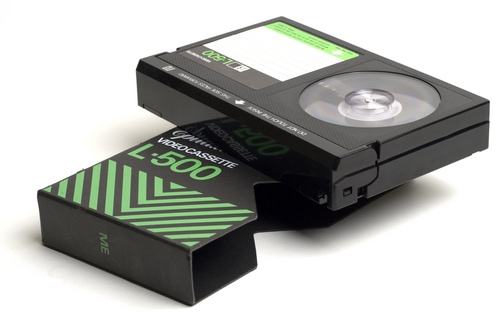The Betamax format
 The Betamax format was released by Sony in 1975. Sony already invented the U-matic format for industry purposes and wanted to cover the home video sector as well. Betamax tapes are slightly smaller than VHS and only have one viewing window.
The Betamax format was released by Sony in 1975. Sony already invented the U-matic format for industry purposes and wanted to cover the home video sector as well. Betamax tapes are slightly smaller than VHS and only have one viewing window.
Although the format outclassed its competitors, it was not able to prevail against the VHS. Betamax produces a sharper picture and requires about 20% less tape. But Sony was very hesitant concerning the licensing for other manufacturers and also attached conditions for high investments in own production plants. The VHS manufacturer JVC was more generous and enabled a faster distribution of its own format.
Durations
Betamax cassetten have different durations:
| Tape labeling |
Duration |
| L-125 |
30 minutes |
| L-165 |
45 minutes |
| L-250 |
65 minutes |
| L-370 |
95 minutes |
| L-500 |
130 minutes |
| L-750 |
195 minutes |
| L-830 |
215 minutes |
Durability
Like all types of video cassettes, Betamax tapes are vulnerable to environmental influences. That’s why you should pay attention to some things when it comes to storing your tapes:
- Rewind your cassettes before storing them away
- Put the tapes into a case to protect them from dust and dirt
- Ensure that your Betamax are stored at room temperature and no direct sunlight
- Keep the storage place dry
- Keep the tapes away from magnetic interference fields like TVs
The Betacam format
The Betacam format was developed by Sony in 1982 as a professional video format. It is the successor of the Betamax format has the same build. But there are differences in the recording system, so that Betacam and Betamax are not compatible with each other. Betacam cassettes are smaller than VHS and have a maximum duration of 36 minutes. The format was mainly – even to this day – used in the professional TV sector for electronic reporting. In 1986 the format was further developed and resulted in a more compact version called Betacam SP. MEDIAFIX digitises your Betacam starting at £10.99.
 It's summer time - and the temperatures are causing your old media to suffer. Convert Betamax and Betacam to digital today and preserve your valuable memories. Enjoy your converted photos and films with family and friends on your PC or TV.
It's summer time - and the temperatures are causing your old media to suffer. Convert Betamax and Betacam to digital today and preserve your valuable memories. Enjoy your converted photos and films with family and friends on your PC or TV.




 The Betamax format was released by Sony in 1975. Sony already invented the U-matic format for industry purposes and wanted to cover the home video sector as well. Betamax tapes are slightly smaller than VHS and only have one viewing window.
The Betamax format was released by Sony in 1975. Sony already invented the U-matic format for industry purposes and wanted to cover the home video sector as well. Betamax tapes are slightly smaller than VHS and only have one viewing window.